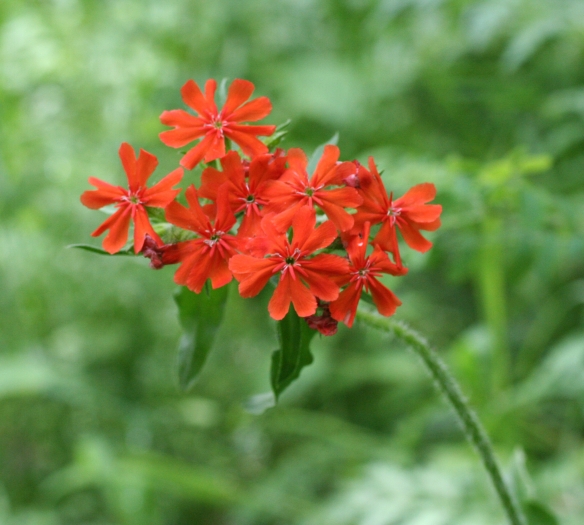Maltese Cross
(Silene chalcedonica)
Maltese Cross (Silene chalcedonica)
/
/

Oleg Kosterin
CC BY 4.0
Image By:
Oleg Kosterin
Recorded By:
Copyright:
CC BY 4.0
Copyright Notice:
Photo by: Oleg Kosterin | License Type: CC BY 4.0 | License URL: http://creativecommons.org/licenses/by/4.0/ | Rights Holder: Oleg Kosterin | Publisher: iNaturalist | Date Created: 2020-06-21T13:59:26-07:00 |










































Estimated Native Range
Summary
Silene chalcedonica, commonly known as Maltese Cross or Scarlet Lychnis, is a perennial herbaceous plant native to open woodlands and meadows of Eastern Europe and Asia, including Russia and Siberia. It grows 35–100 cm (1.1–3.3 ft) tall with unbranched stems. The species is characterized by its bright red flowers, which are produced in dense clusters of 10-50. Each flower measures 1–3 cm (0.4–1.2 in) in diameter with a deeply five-lobed corolla; each lobe is further split into two smaller lobes, creating a striking display. The flowering season typically occurs in summer, and the flowers are highly showy, making it a favorite among gardeners for its ornamental value.
Maltese Cross is celebrated for its vibrant red flowers, which have earned it the Royal Horticultural Society’s Award of Garden Merit. It is commonly used in border plantings, cottage gardens, and as a cut flower due to its striking appearance. This plant thrives in partial to full sun and prefers well-drained soils, although it requires consistent moisture to flourish. Deadheading, or the removal of faded flowers, can prolong the blooming period. While it is adaptable to various soil types, it is short-lived in poorly drained conditions. Gardeners should be aware that Silene chalcedonica can be potentially invasive outside its native range and should check local guidelines before planting.CC BY-SA 4.0
Maltese Cross is celebrated for its vibrant red flowers, which have earned it the Royal Horticultural Society’s Award of Garden Merit. It is commonly used in border plantings, cottage gardens, and as a cut flower due to its striking appearance. This plant thrives in partial to full sun and prefers well-drained soils, although it requires consistent moisture to flourish. Deadheading, or the removal of faded flowers, can prolong the blooming period. While it is adaptable to various soil types, it is short-lived in poorly drained conditions. Gardeners should be aware that Silene chalcedonica can be potentially invasive outside its native range and should check local guidelines before planting.CC BY-SA 4.0
Plant Description
- Plant Type: Herb
- Height: 2-3 feet
- Width: 0.667-1 feet
- Growth Rate: Moderate
- Flower Color: Red
- Flowering Season: Spring, Summer
- Leaf Retention: Deciduous
Growth Requirements
- Sun: Full Sun
- Water: Medium
- Drainage: Medium
Common Uses
Bee Garden, Bird Garden, Border Plant, Butterfly Garden, Deer Resistant, Groundcover, Hummingbird Garden, Low Maintenance, Rabbit Resistant, Salt Tolerant, Showy Flowers
Natural Habitat
Open woodlands and meadows of Eastern Europe and Asia, including Russia and Siberia
Other Names
Common Names: Maltese Cross, Scarlet-Lychnis, London Pride, Maltese-Cross, Maltese-Cross Campion, Scarlet Lychnis, Brennende Liebe, Croix De Jérusalem, Lychnide De Chalcédoine, Croix De Malte
Scientific Names: , Lychnis chalcedonica, Silene chalcedonica, Agrostemma chalcedonica, Lychnis bicolor, Lychnis fulgida,
GBIF Accepted Name: Silene chalcedonica (L.) E.H.L.Krause